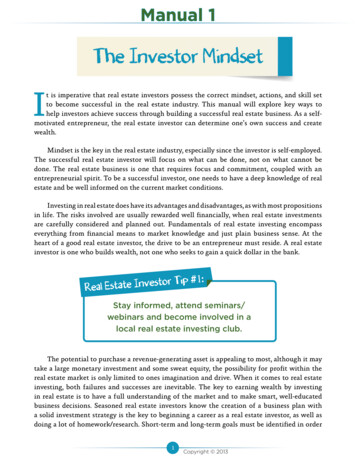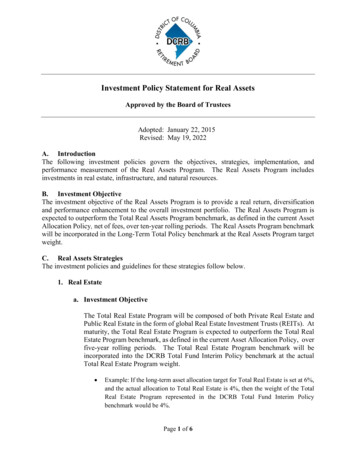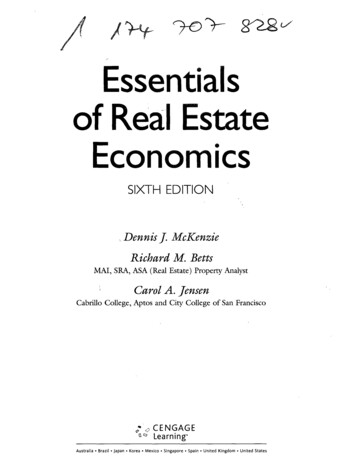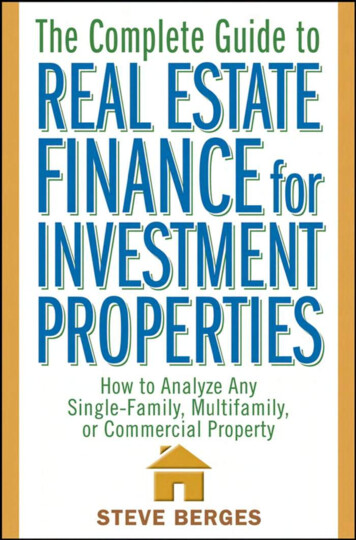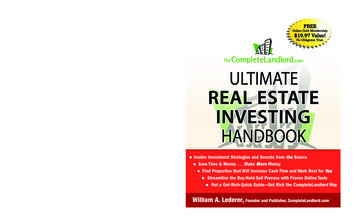
Transcription
Real EstateLedererThe“The CompleteLandlord.com Ultimate guides are not just a series of three books—it is acomprehensive, integrated system including extensive Web resources to make the task oflandlording profitable, rewarding, and even fun. Experience may be the best teacher, butit doesn’t have to be your own experience! Bill Lederer and his team have over twentyfive years’ experience in all aspects of landlording. Let him provide all the information andsystems you need to be a successful real estate investor.”—Dr. Dolf de Roos, author of the New York Times bestseller Real Estate RichesBecome the ULTIMATE REAL ESTATE INVESTOR!As the go-to resources for real estate investors and rental operators around the country,William Lederer’s CompleteLandlord.com real estate guides cover the A-to-Z of landlording,real estate investing, and property management. In addition to hard-earned wisdom and handytools, each book includes a free one-month trial membership to CompleteLandlord.com—a 19.97 value!Inside, you’ll find answers to the following questions, and more: Should you focus on short-term or long-term strategies? How can you find the best and most profitable properties to invest in? How do you get the best deal when negotiating financing or refinancing? What can you do to protect your investments in a dicey investing climate? When is the best time to invest in residential properties? How do you assemble a team of professionals to help? How do you flip properties to get the highest resale price?WILLIAM A. LEDERER is Founder and Publisher of CompleteLandlord.com, the leading Web sitewritten for and by landlords. This proven, one-stop portal offers comprehensive content, commerce,an online landlord community, and on-demand solutions that include customizable forms andletters, as well as tools for tenant screening, vacancy marketing and tenant communications,electronic rent collection, and Web-based property management. Experts in virtually every aspectof landlording, Lederer and his wife have been investors and landlords for many years.Cover Design: Mohammed Ejaz Ali 19.95 USA/ 21.95 CANULTIMATE REAL ESTATE INVESTING HANDBOOKThe CompleteLandlord.com Ultimate Real Estate Investing Handbook offers total coverage ofthe ins and outs of successful investing, from fixing and flipping to long-term buy-and-holdstrategies. Unlike any other book, this practical guide includes a complete success systemthat extends beyond the book to the CompleteLandlord.com Web site, known to tens ofthousands of CompleteLandlord members as the bible for property managers and real estateinvestors alike.William A. Lederer, Founder and Publisher, CompleteLandlord.com
JWBT041 FM.indd ii12/16/08 8:39:35 PM
ULTIMATEREAL ESTATEINVESTINGHANDBOOKJWBT041 FM.indd i12/16/08 8:39:34 PM
JWBT041 FM.indd ii12/16/08 8:39:35 PM
ULTIMATEREAL ESTATEINVESTINGHANDBOOKWilliam A. LedererJohn Wiley & Sons, Inc.JWBT041 FM.indd iii12/16/08 8:39:35 PM
This book is printed on acid-free paper. oCopyright 2009 by Minotaur Media, LLC. All rights reserved.Published by John Wiley & Sons, Inc., Hoboken, New Jersey.Published simultaneously in Canada.No part of this publication may be reproduced, stored in a retrieval system, or transmittedin any form or by any means, electronic, mechanical, photocopying, recording, scanning, orotherwise, except as permitted under Section 107 or 108 of the 1976 United States CopyrightAct, without either the prior written permission of the Publisher, or authorization throughpayment of the appropriate per-copy fee to the Copyright Clearance Center, Inc., 222Rosewood Drive, Danvers, MA 01923, (978) 750-8400, fax (978) 646-8600, or on the web atwww.copyright.com. Requests to the Publisher for permission should be addressed to thePermissions Department, John Wiley & Sons, Inc., 111 River Street, Hoboken, NJ 07030,(201) 748-6011, fax (201) 748-6008, or online at http://www.wiley.com/go/permissions.Limit of Liability/Disclaimer of Warranty: While the publisher and author have used their bestefforts in preparing this book, they make no representations or warranties with respect to theaccuracy or completeness of the contents of this book and specifically disclaim any impliedwarranties of merchantability or fitness for a particular purpose. No warranty may be createdor extended by sales representatives or written sales materials. The advice and strategiescontained herein may not be suitable for your situation. You should consult with a professionalwhere appropriate. Neither the publisher nor author shall be liable for any loss of profit or anyother commercial damages, including but not limited to special, incidental, consequential, orother damages. “This product is not intended to provide legal or fi nancial advice or substitutefor the advice of an attorney or advisor.”For general information on our other products and services or for technical support, pleasecontact our Customer Care Department within the United States at (800) 762-2974, outside theUnited States at (317) 572-3993 or fax (317) 572-4002.Wiley also publishes its books in a variety of electronic formats. Some content that appears inprint may not be available in electronic books. For more information about Wiley products,visit our web site at www.wiley.com.ISBN: 978-0-470-32316-8Printed in the United States of America.10JWBT041 FM.indd iv98765432112/16/08 8:39:36 PM
In honor of my family: Renda, Adam, Eric, and Muriel Lederer;To Jill, John, Robert, Sarah, and Edward Doherty; Peggy, Marc (oneof America’s great real estate investors and landlords), Josh, Davis,and Chloe Blum;And in memory of Frederick Lederer, Beverly and Irwin Lippmann,and Stella Natenberg, anyone’s idea of a great real estate asset andteam memberJWBT041 FM.indd v12/16/08 8:39:36 PM
JWBT041 FM.indd vi12/16/08 8:39:37 PM
CO N T E N T SAcknowledgments xvList of Icons xviIntroduction xviiAbout This BookxviiiSECTION ONE: BECOMING A PROPERTYINVESTOR 1Chapter 1 New Investors: Why and When to Invest inResidential Income Property 3Reaping the Rewards 4Patterns to Follow 5The Megalopolitan Era 7Chapter 2 Getting Your Financial House inOrder 10How Hard Can It Be? 10Step 1: Figure Out Your Net Worth 12Step 2: Consider a Financial Advisor 14Step 3: Consult Experts in the Real Estate FieldA Final Point 2319Chapter 3 Your Options: Self-Directed Real EstateIRAs, 1031 Property Exchanges, and Tenantsin-Common 24Self-Direction 24Swapping It Out 27Tenants in Common 30viiJWBT041 FM.indd vii12/16/08 8:39:37 PM
viiiCONTENTSChapter 4 Legal, Financial, and TaxConsiderations 33Freehold Estates 34Nonfreehold Estates 39Forms of Ownership 39SECTION TWO: WINNING RESIDENTIAL INVESTMENTSTRATEGIES 55Chapter 5 Which Is the Right Strategy and Property forYou? 57Nuts and Bolts of It 57Find a Healthy Starting Point 59Stocks 60Bonds 60Cash 60Real Estate 61Precious Metals 61Energy 61Investing by the Numbers 62The Big Picture 65Do Your Homework 65Chapter 6 Your Choices: Single-Family, Condo, Co-Op,Vacation Home, and Multiplexes 69Useful Definitions 69Financing 79Tax Issues 80Chapter 7 Understanding Zoning and BuildingCodes 81Use Restrictions 81Environmental RestrictionsOccupancy Rules 82Heights and Setbacks 82JWBT041 FM.indd viii8212/16/08 8:39:37 PM
ixContentsArchitectural/Landmark/Design Restrictions 82Keeping a Low Profile 83Arm Yourself 83Chapter 8 The Flipping Phenomenon, Preforeclosures,Foreclosures, and Short Sales 84Learning Tough Lessons about Financing 86Locating Properties You Can Flip 87Target Numbers—What to Shoot For 88Consider Tax Consequences 89Beware of Fraud 91The Foreclosure Option 92Do Your Homework 93Your Bank Is Your Ally 94Preforeclosure 95Short Sales 96Public Auction Approach 97Federal Agencies Sell Homes, Too 99Hidden Foreclosures 100Probate 100Develop a System for Inspecting Properties 101Chapter 9 Creative Real Estate Investing 105Tax Liens 105Tax Deeds 106Wholesaling 107Buying Mortgages 107SECTION THREE: CREATING YOUR ACTIONPLAN 109Chapter 10 Your Winning Business Strategy, ActionPlan, and Team Building 111The Real Estate Agent 111How to Hire a Real Estate AgentGoing It Alone 117JWBT041 FM.indd ix11312/16/08 8:39:38 PM
xCONTENTSChapter 11 Accountants and Lawyers 124Choosing a Professional 125Accounting 101 127Chapter 12Networking Your Way to SuccessWhere to Start 131Maximize the InteractionChapter 13130131Legal and Asset Protection Strategies 133The Business Plan 134The Process 135Projecting Income and Cash FlowYour Business Entity 136The Legalities of It All 145136SECTION FOUR: BUYING SMART FROM OFFER TOCLOSING 163Chapter 14 Financing Your Property 165Growth of Mortgage Offerings 166Alternative Loan Options 166Risky Mortgages or Risky Borrowers? 170The Future of Lending 172Chapter 15 Determining Value through Property andInvestment Analysis 173Role of the Appraiser 174Current Marketplace 176Chapter 16 Buying Rental Property: Reality Checksbefore Buying 178Reality Check No. 1: This is Not Your Personal Space 178Reality Check No. 2: Numbers Never Lie—Unless You WantThem To 179JWBT041 FM.indd x12/16/08 8:39:38 PM
xiContentsReality Check No. 3: Looks Are Everything 180Reality Check No. 4: Do-It-Yourself Means Exactly That 180Reality Check No. 5: Be Prepared to Walk Away 181Do Your Homework 181Chapter 17 Residential Income Property DueDiligence 182SECTION FIVE: FIX IT: WHAT THE SUCCESSFUL FIXERUPPER NEEDS TO KNOW 187Chapter 18Creating Curb Appeal189The Home’s Exterior 189The Home’s Interior 191Chapter 19Handling the Competition 193Prepare Yourself with KnowledgeKey Competitive Strategies 194Chapter 20193The Limits of Do-It-Yourself 198Adding Up the Expenses 199Becoming Your Own Contractor 201Handling Stress 202Think before You Leap 202Chapter 21 Creating an Exit Strategy 203Establish Your Goals204SECTION SIX: HOLD VERSUS SELL: OWNINGPROPERTY AS A LONG-TERM INVESTMENT207Chapter 22 Life as a Landlord: Is There Equity withoutSweat? 209The Basics 210Application ProcessJWBT041 FM.indd xi22212/16/08 8:39:39 PM
xiiCONTENTSLease Signing 223Insured and Bonded 226Renter’s Insurance or Self-Insured ResponsiblityIt’s Your Choice 229226Chapter 23 When the Rent Check Does Not Arrive: APrimer in Cash Flow Management 230Cash Flow Management 231Crucial Calculation: The Cap RateSale Price 233Do the Math 233232Chapter 24 Flipping in Action: How the ProsDo It 234The Quick, No-Frills Flip 234Spotting the Right Properties 235Need for Low Overhead 236Disaster Recovery—The Next Flipping FrontierTighter Scrutiny 237Flipping Ethics 238It Is All about Margin of Error 238Cost of Contingencies 239Easier than It May Sound 240236Chapter 25 Careers, Networking, and ContinuingEducation in Professional Residential PropertyInvesting 241Full Time or Part Time?APPENDIXES242245Appendix A Summary of Icon Information inAppendix 247Money Savers 247Money Makers 247Time Savers 248JWBT041 FM.indd xii12/16/08 8:39:39 PM
xiiiContentsAppendix B Tour of the CompleteLandlord Site withFree Trial Membership Offer 249Appendix C Essential CompleteLandlord Worksheets,Checklists, and Other Forms 269Appendix DAssociations and Other ResourcesAppendix EGlossary of Real Estate Terms290293Index 311CLL Catalog 327JWBT041 FM.indd xiii12/16/08 8:39:39 PM
JWBT041 FM.indd xiv12/16/08 8:39:39 PM
AC K N OW L E D G M E N T SI am pleased to acknowledge those without whose help and guidanceneither this series nor my landlording odyssey would be complete: My copy, editorial, graphics, and marketing team of BridgetMcCrea, Shannon Vargo, Linda Indig, Mohammed Ejaz Ali, BrianNeill, Beth Zipko, and Kim Dayman, who really pulled through forme and to whom I am much indebted. A big thank you and recommendation to the best non-fiction literary agent in America and mygreat friend, Cynthia Zigmund.My inspirations: the courageous, selfless and impactful John Woodof Room to Read, business leader and good friend Dean Debiase,and real estate entrepreneur/attorney/friend Dr. Arnold S. Goldstein, Esq.My wife Renda and mother Muriel deserve much credit for thisultimate series, our education in landlording, and the staying forceto persist. Too seldom do family members get their due in theseendeavors. I have been blessed beyond belief.My long-time colleagues Enid Becker, Jonas Hedsund, andJay Rawlings; accountant and lawyers Harry Kramer, StewartSchechter, Peter Lieberman, and Todd Mazur; and my formercolleagues Bruce Masterson, Cindy Fitzgerald, and Paul Barrett.Mona Hellinga as my favorite and utterly professional residentialreal estate agent.My friends and business partners at Buildium propertymanagement software, including Michael Monteiro and DimitriGeorgakopoulos.xvJWBT041 FM.indd xv12/16/08 8:39:40 PM
LI S TO FI C O N SMoney SaversThese sections are designed to save you money. Use the information inthem to make frugal decisions regarding your cash outlay when investing in and running your properties.Money MakersHere’s where you’ll learn how to make money in real estate. Ferret outthe best possible tips and advice from these sections of the book andyou’ll be well braced to earn a living and more from your real estateinvestments.Time SaversWe know there are only so many hours in a day, so use these areas of thebook to shave precious time from your schedule and maximize the timespent on your landlording and real estate investment business.xviJWBT041 FM.indd xvi12/16/08 8:39:40 PM
IN T R O D U C T I O NThere’s nothing quite like starting a new business venture. The slate isclean, your enthusiasm is peaked, and your passion is serving as the rudder as you make your way through the learning years. This time, you’relooking to get a piece of the real estate pie that many others have alreadycome to rely on for income, and you’re going to do it through a targetedinvestment process.Well, you’ve come to the right place. This book, in combinationwith the landlording and real estate property management books thatcomplete this series, will equip you to take on just about anythingthat comes your way as a real estate investor.This book is designed to serve you, the reader, in several ways.You can read it from cover to cover, stick to those sections that are mostapplicable to your situation, and/or supplement it with the knowledgethat you’ll fi nd in the other two volumes. Regardless of how you tackleit, the key is for you to come away with a broad knowledge of exactlywhat it means to be a successful real estate investor.From this book, you’ll take away valuable knowledge aboutresidential real estate investment, find out which options are mostappropriate for your individual situation, get the inside track on legaland asset protection strategies, and of course, learn how to source,value, negotiate, finance, and refinance properties.If you want to know what makes us experts in this field, considerthe fact that CompleteLandlord.com has already helped hundreds ofthousands of property investors—who combined own millions of rentalunits—save time and money. We believe life is short and it’s importantto manage properties efficiently, easily, and profitably.The editorial team at CompleteLandlord.com, publisher of theLandlord Profit Letter and numerous special reports, and books andmonitors of the CompleteLandlord Forum, has more than 25 years oflandlord, property investment, rental management, and overall real estateexperience. We also have a dedicated staff of attorneys and advisorswho review our articles and forms library to ensure their accuracyxviiJWBT041 FM.indd xvii12/16/08 8:39:41 PM
xviiiINTRODUCTIONand compliance with all federal, state, and local real estate laws. Or simply put, they help us ensure all our i’s are dotted and t’s are crossed.CompleteLandlord.com is for people like you: landlords and property investors. It’s the online destination that thousands of savvy landlords and real estate investors go to for real-world advice on managingproperties and tenants, as well as to pick up products, services, andessential forms. All our efforts are aimed at helping people run a moreprofitable and successful real estate business.We’ve also assembled a diverse advisory team of more than a dozenlandlords from places like Ohio, Texas, Georgia, and Illinois (just to namea few). This team is not afraid to mix it up and share the real scoop onwhat it’s like to be a landlord. They review and comment on (and sometimes argue about) our product in order to share insights with us (andyou) on money- and time-saving strategies and tips to help build realwealth with investment properties. The advisory team includes landlords who own, manage, and have sold both large and small multi- andsingle-family properties, as well as other investment real estate.Now it’s time to turn the page and start learning the ropes of realestate investing. We will guide you through the process, helping youthrough the hurdles, and supporting you in your quest to reach yourHoly Grail: successful real estate property investing. Good luck inyour venture!About This BookThis book is written for the first-time real estate investor. Note that we didnot use the word homeowner when describing our readers becausehomeowners “own” a piece of real estate as a primary residence. Whilethey may enjoy the tax benefits they have accrued and be gratified tosee their property’s value increase, they should not think of a long-termresidence as an investment. This is because a permanent residence oftenhas practical and emotional components that true investments shouldnot have.Much like a stock or a bond, a real estate investment should bean entity that an individual or group will buy or sell as market conditions warrant. There shouldn’t be any emotional ties to an investment.JWBT041 FM.indd xviii12/16/08 8:39:41 PM
IntroductionxixAnd while some people make money moving into fi xer-uppers, makingupgrades, and then moving on, these short-term living scenarios cannot becalled true homes. They are a means of making money in the short term orcreating income in the long term and should be viewed as investments.It may seem a curious mindset, but one that should be adoptedby anyone who plans to successfully invest in real estate. The purpose of this book is to introduce new investors to the best manner ofresearching, financing, buying, and selling investment property. Indoing so, we’ll explore the phenomenon of flipping—choreographedbuying, refurbishing, and selling of properties during a short period formaximum returns.We’ll also look at the kind of buy-and-hold strategies for real estateownership that might make sense to more cautious investors. This isimportant since the professionals at CompleteLandlord see flipping asa full-time business. People who are truly successful at investing needto develop a strong business mindset and an infrastructure based onfinancing options, a support team (brokers, attorneys, tax advisors, andso forth), and an ability to gauge changing market conditions so thatthey can maximize profit based on minimum investment.Those who make a living flipping property do not necessarilymake large profits on every sale, which is why it is important to havea thorough understanding of market conditions before entering eachtransaction. This is not to say that those who decide to take advantageof a sudden opportunity in real estate cannot make a quick return. Ithappens every day. But taking the time to fully understand real estateinvestment as a business ensures that success comes from knowledgeinstead of favorable market conditions and pure luck.Along with reading this book, we encourage you to read, watch,and listen to everything around you on this subject. The best skill anyinvestor can have is the desire and ability to absorb all the informationhe or she can and then take the time to determine whether that adviceis worthwhile. This book is one more piece of information an investorshould consider before investing.Despite the headlines and broadcasts promising quick riches, realestate investment requires individuals to become experts—expertsabout financing, types of properties, and, most importantly, market conditions as they change. Potential investors need to consult a wide varietyof resources before they begin the process of buying and selling realestate for profit.JWBT041 FM.indd xix12/16/08 8:39:42 PM
xxINTRODUCTIONThe best real estate investors stay abreast of current trends in thereal estate market on a local and national level. They read relevant information, talk to those with information, and are able to zero in on smallpockets of success in real estate. Migration patterns, particularly thoseof older Americans who have been homeowners for a long time, arecritical to watch as the baby boomer generation moves into retirement.Combine all of this information and put it to work in your own realestate investment strategy and you’re sure to come out a winner.JWBT041 FM.indd xx12/16/08 8:39:43 PM
S E C T I O NONEBecoming a Property InvestorJWBT041 ch01.indd 112/16/08 8:40:03 PM
JWBT041 ch01.indd 212/16/08 8:40:03 PM
C H A P T E R1New Investors: Why and Whento Invest in Residential IncomePropertyThe investment psyche of many Americans has undergone a majorreversal since 2000. That’s because for most of the 1980s and 1990s, theplace to invest money was the stock market, propelled in no small partby the creation of 401(k) plans that put ordinary investors in the driver’sseat of their personal finances as never before.Although the stock market was previously the domain of the rich,the “common man” suddenly found himself dabbling in—and makingmoney in—uncharted territory. Investment self-determination—with orwithout professional advice and information—became the way to go.Online stock-trading sites helped drive the trend, allowing anyone withmoney to open an account and become a day trader overnight.Enter the tech wreck of April 2000, and a subsequent market slidetriggered by the September 11, 2001, terrorist attacks. Both events leftinvestors with tattered portfolios and an uncertain view of the future.Anyone made into a day trader by the advent of E*Trade or Ameritradewas suddenly left longing for what they had in the 1990s: double-digitinvestment games with little or no effort.Even as stock prices fell and once-revered dot-com businessesdisappeared (taking billions of dollars of venture capital with them),the U.S. real estate market continued to soar. It would, in fact, propup the U.S. economy for years to come, and continues to do so in spiteof the residential market contraction that took hold in 2006.3JWBT041 ch01.indd 312/16/08 8:40:03 PM
4BECOMING A PROPERTY INVESTORReaping the RewardsToday, more Americans are investing in real estate to reap its financialrewards. Though owning property has historically been a sound investment, most buyers looked no further than their primary residence. Thathas since changed. Fueled by low interest rates, rapid appreciation, anda growing number of ways to borrow money, many Americans nowview real estate as a safe financial investment—and one more lucrativethan the stock market in recent years.A 2007 analysis of U.S. Census Bureau data shows there are 6.8 million vacation homes nationwide, along with 37.4 million investmentunits and 74.6 million owner-occupied units.According to the National Association of Realtors’ (NAR) 2007Investment and Vacation Home Buyers Survey, the combined total ofvacation and investment home sales accounted for 33 percent of allexisting and new home sales, which is close to historic norms.NAR reports that the market share of homes purchased for investment in 2007 was 21 percent, down from 22 percent in 2006, whileanother 12 percent were vacation homes, compared with a 14 percentmarket share in 2006. Fifty-nine percent of vacation homes purchasedin 2007 were detached single-family homes, 29 percent condos, 7 percent townhouses or row houses, and 5 percent other. In 2006, detachedsingle-family homes accounted for 67 percent of vacation home sales,while condos were 21 percent.As you can see, the real estate investment market wasn’t immune tothe overall fallout within the residential sector: NAR found that investment home sales fell 18.1 percent to 1.35 million in 2007, from 1.65 millionin 2006. By comparison, primary residence sales declined 10.0 percentto 4.34 million in 2007 from 4.82 million in 2006. NAR reported that themedian price of a vacation home was 195,000 in 2007, down 2.5 percentfrom 200,000 in 2006. The typical investment property cost 150,000in 2007, a number that was unchanged compared to 2006.Real Estate Investor InsightsYou are seeing people now for whom investing in real estate is theirlife. They are quasi-pro and amateur investors driven by the idea of selfsufficiency. This is their way to become financially independent. It is amove taken straight from the old day traders of the stock market.—Jay Butler, director of the Real Estate Centerat Arizona State UniversityJWBT041 ch01.indd 412/16/08 8:40:04 PM
New Investors: Why and When to Invest in Residential Income Property5Patterns to FollowReal estate, like any investment market, consists of patterns that repeatthemselves.Some call them cycles. Knowledgeable investors continue to buyin all markets, not just good ones. In fact, some of the best make theirmove when the market is down.Following market trends, and knowing when, where, and what tobuy, is the key to successful real estate investing.Do You “Get” It?Successful real estate investors understand trends on a micro level, whichmeans researching the local community in which you plan to invest. Youneed to know answers to questions such as: JWBT041 ch01.indd 5What is the job outlook in this community? A healthy economy(signs of new business growth and a solid job market) is a good indication that local residents are securely employed and thereforeare able to meet their financial obligations.Has the local cost of living changed? That is, can older residentsafford to stay and can younger ones afford to move in?How much land remains undeveloped? In a mature community,with little room for new development, there is often intense competition for property.What has happened to home and commercial real estate pricesin the past 5, 10, or 15 years? Understanding when and why pricesincreased, decreased, or stalled in the community is crucial. Realestate markets often stall when a major employer has moved outor boom when a new one has moved in. Knowing the commercialreal estate market provides important information about the localeconomy. Commercial real estate vacancies mean lower rates ofemployment in the community.If job losses or gains are occurring, what industries are involved?What type of impact is this likely to have on the local housing market? Job losses at a small, nonunion factory will affect a differentreal estate market than those at a large community hospitalbecause factory employees and medical personnel may occupydifferent sectors of the housing market.(continued )12/16/08 8:40:04 PM
6BECOMING A PROPERTY INVESTORDo You “Get” It? (Continued ) Where are the largest new real estate developments? Who isresponsible for them? Knowing the largest residential developersin the community, and watching their movements, may help youidentify the next area of growth.Is the city or township government in good financial shape? Acommunity in budget trouble is a community that may be forcedto raise taxes or change zoning requirements to bring in morerevenue. Higher taxes can scare away many potential buyers, andzoning changes (e.g., those that allow more industry or fast-foodbusinesses) may bring in more revenue but will result in a lessattractive community.Why is this important? Well, it makes sense to have a workingknowledge of what various property markets around the country aredoing, even if you plan to invest only locally, because it provides an understanding about what makes a community more or less valuable.IMPORTANT NOTEThe federal government, and particularly the U.S. Census Bureau, keeps manystatistics relative to population, housing, rental property, and beyond. Visitwww.census.gov for more information, or bookmark this site as an additionto your resource file.One particularly good way to make good investment choices is bylooking at market demographics, or more simply, who is buying whatand where. A recent Harvard study, for example, shows that over thepast two decades the number of heads of households that were foreignborn or the native-born child of an immigrant rose to one in five (RentalProperty Investing, Minotaur Media LLC, 2006). Today, more than25 percent of all households are headed by minorities, a statistic largelyattributed to the rise in the nation’s immigrant population.The trend of nontraditional households is rising as well. As of 2000(the most recent U.S. Census data available), single-person households—unmarried couples, single female heads of households, and singlesJWBT041 ch01.indd 612/16/08 8:40:05 PM
New Investors: Why and When to Invest in Residential Income Property7without children—numbered 26.5 million. The never-married share ofhouseholds has been on the upswing since the first group of baby boomers reached adulthood.The study also found that 43 percent of heads of householdsyounger than age 35 have never married, in contrast to only 26 percentof their same-age counterparts in 1980. The growth of these two groupsmay lead to the largest net household growth since the baby boomersentered the housing market in the 1970s. This should be food for thoughtas you go about purchasing and renting out investment real estate.Minority ReportWhen it comes to real estate, the fastest-growing group in the market isethnic minorities.Though the Harvard report points out that “the minority share of homeremodeling activity and trade-up home buying is up only slightly, the increase in the rental and first-time buyer markets is dramatic. With theirhigh immigration
Chapter 9 Creative Real Estate Investing 105 Tax Liens 105 Tax Deeds 106 Wholesaling 107 Buying Mortgages 107 SECTION THREE: CREATING YOUR ACTION PLAN 109 Chapter 10 Your Winning Business Strategy, Action Plan, and Team Building 111 The Real Estate Agent 111 How to Hire a Real Estate Agent 113 Going It Alone 117
